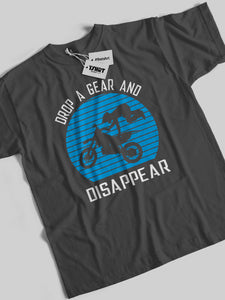Why a ₹499 T-Shirt Might Last Longer Than Your ₹1999 One
Let’s flip the script.
You’d expect the more expensive product to last longer. That’s the rule, right?
But when it comes to t-shirts, especially in today’s fashion industry — that rule is being broken more than ever.
In fact, a lot of men are discovering that their ₹499 t-shirts are outlasting the ₹1999 ones.
And it's not by luck — it’s by design.
First, Understand What You’re Paying For
Let’s break down a ₹1999 t-shirt from a big-name fashion label. Here's where your money likely goes:
-
₹350–₹450 on actual material and stitching
-
₹200–₹300 on packaging, shipping, warehousing
-
₹800–₹1000 on marketing and brand markup
-
₹200–₹400 on physical store expenses
Now, let’s look at that ₹499 t-shirt from a quality-driven independent brand:
-
₹250–₹300 on better quality cotton (yes, better!)
-
₹50–₹100 on direct shipping
-
Minimal marketing, no mall stores, no inflated pricing
Result? More of your money goes directly into the t-shirt — not into the brand’s lifestyle image.
Why Cheaper Can Mean Stronger
1. Fabric Selection Based on Function, Not Fashion
Smaller brands, especially homegrown ones, often prioritize long-term comfort over trendy textures.
They’re using:
-
Mid-weight 100% cotton (more durable)
-
Pre-shrunk fabric to prevent post-wash surprises
-
Colorfast dyes to reduce fading
Meanwhile, premium brands may pick fabric for how it looks or feels on a shelf — which often sacrifices durability.
2. Mass Production = Faster Cuts, More Errors
A ₹1999 t-shirt from a major brand is typically made in a high-speed production line. It’s stitched by workers doing thousands of pieces a day. Corners get cut.
But smaller-scale t-shirts from quality-focused labels?
They're made in batches, with more attention to seam strength, symmetry, and finish.
That ₹499 tee might have double-stitched shoulders or better neckline tape — tiny details that keep it from falling apart after five washes.
3. Fit That’s Made to Last, Not Made for the Hanger
High-end brands often design t-shirts to look perfect on mannequins or hangers — ultra slim, too tight, or overly boxy. These fits often lose structure quickly in daily wear.
Compare that to a ₹499 tee made with:
-
Room in the shoulder seams
-
Balanced drape for movement
-
Slight give in the sleeves and body
It’s not just more comfortable — it holds up better over time.
4. Branded Doesn’t Mean Better-Stitched
Have you ever noticed that “premium” tee developing loose threads after a couple of wears? That’s because branding and quality are not the same thing.
A ₹499 t-shirt made with:
-
Flatlock seams
-
Cover-stitched hems
-
Lycra-blended rib collars
…is functionally superior to a tee that just says "luxury" on the tag.
Quick Real-World Test: Try This at Home
Take one of your ₹1999 tees and one under ₹600. Try these 3 tests:
|
Test |
Expensive Tee |
₹499 Quality Tee |
|
Wash test (3x) |
Color fade? Shrink? Collar waves? |
Still true to size and shade |
|
Stretch test |
Neckline loosened? |
Snaps back? Holds shape? |
|
Touch test after a week |
Feels thinner? Pilled fabric? |
Still soft, solid feel |
More often than not, the winner isn’t the one with the fancy label.
Smart Shoppers Are Paying Less — On Purpose
We’re living in an era where buyers are smarter.
They’ve figured out that “more expensive” doesn’t always mean “better made.”
They’re comparing GSM counts. They’re reading fabric tags. They’re asking:
“What am I really paying for?”
And they’re building wardrobes with:
-
Affordable staples
-
Reliable quality
-
Clean, versatile designs
Not for trends — but for everyday living.
Final Thought: Style That Lasts Doesn’t Need a ₹2000 Tag
There’s a strange sense of satisfaction in wearing a t-shirt that cost half the price, looks just as good, and survives twice as long.
So next time you’re shopping, don’t just look at the logo.
Look at the fabric, the fit, and the finish.
Because in 2025, smart style is about value, not vanity.


















Comments (0)
No comments yet. Be the first to share your thoughts!
Leave a Comment